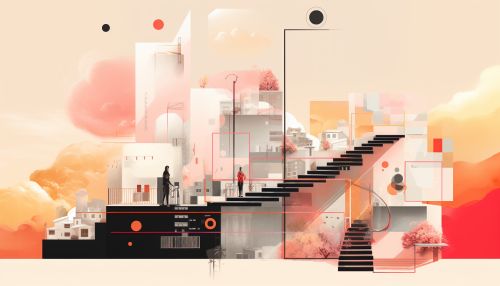Hierarchy in Graphic Design
Introduction
Hierarchy in graphic design is a fundamental concept that refers to the arrangement and presentation of elements in a way that implies importance. It plays a crucial role in the visual layout and prioritization of information. It can guide the viewer's eye to where a message needs to be communicated. This is achieved by varying the size, color, and placement of certain elements to establish their relative importance in the design.


Understanding Hierarchy in Graphic Design
Hierarchy in graphic design is not just about size and placement, but also about color, contrast, typography, whitespace, and style. These elements can be manipulated to draw attention to or away from certain elements, creating a path for the viewer's eye to follow. This path is often referred to as the 'visual flow' of the design.
Size
Size is the simplest and most common way to establish hierarchy. Larger elements are naturally more noticeable and are often perceived as being more important. This is why headlines are typically larger than body text, and why the most important elements of a design are often the largest.
Color and Contrast
Color and contrast can also be used to establish hierarchy. Bright, bold colors naturally draw the eye, making them a good choice for important elements. Contrast, on the other hand, can be used to make certain elements stand out from their surroundings. This can be achieved by using contrasting colors, or by using light elements on a dark background (or vice versa).
Typography
Typography plays a crucial role in establishing hierarchy. Different typefaces, weights, and styles can all be used to differentiate between levels of importance. For example, headlines are often set in a bold, large typeface, while subheadings might be smaller and lighter. Body text is typically set in a smaller, simpler typeface.
Whitespace
Whitespace, also known as negative space, can be used to create hierarchy by providing visual breathing room for certain elements. This can help to separate different elements and make the design easier to digest. It can also be used to draw attention to certain elements by providing a buffer between them and other elements.
Style
The style of the elements in a design can also contribute to hierarchy. For example, a unique or unusual style can draw attention and signify importance. This can be achieved through the use of graphics, images, or decorative typefaces.
Practical Applications of Hierarchy in Graphic Design
Hierarchy is used in all forms of graphic design, from print design to web design. It is particularly important in designs that contain a lot of information, such as newspapers, magazines, and websites.
Print Design
In print design, hierarchy is used to guide the reader's eye through the design in a logical and intuitive way. This is achieved by using different sizes, colors, and typefaces to differentiate between headlines, subheadings, and body text. Images and graphics are also used to draw attention and add interest.
Web Design
In web design, hierarchy is crucial for usability and accessibility. It helps users to navigate the site and find the information they need quickly and easily. This is achieved by using different sizes, colors, and styles for different elements, such as navigation menus, headings, and links. Interactive elements, such as buttons and forms, are also designed to stand out and be easily identifiable.
Information Design
In information design, such as infographics and data visualizations, hierarchy is used to present complex information in a clear and understandable way. This is achieved by using different colors, sizes, and styles to differentiate between different types of information and levels of importance.
Conclusion
Hierarchy in graphic design is a fundamental principle that is used to guide the viewer's eye and communicate a message effectively. By manipulating size, color, typography, whitespace, and style, designers can create a visual hierarchy that prioritizes information and enhances the overall effectiveness of the design.
